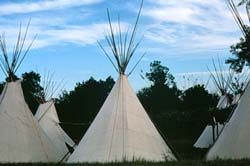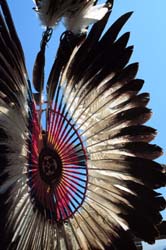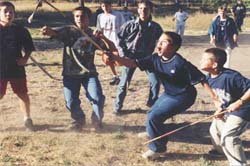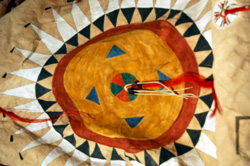Montana Indians
Updated: August 5, 2020

Montana has eleven Indian tribes living on seven reservations. Together they make up about six percent of Montana's population. Before trappers and settlers came west, Indian people roamed freely across the state, following the huge buffalo herds that once covered the plains. Each tribe has unique customs and traditions. While Montana's Indians have worked to adapt to the changing world around them, they have kept the rich culture and traditions of their past. This rich heritage contributes to the distinct flavor of Montana. Their culture is celebrated through dance, songs, games, language, and religious ceremonies. Annual tribal events include rodeos and powwows. Beautiful arts and crafts reflect a special connection between Montana Indians and nature.

Montana's Indian Reservations are filled with native American culture. There are places where Indian customs can be experienced at annual gatherings and celebrations that are performed on sacred lands just as they have been for hundreds of years. At a powwow, guests can join Indians in traditional dress for the "Round Dance" and taste traditional food. The Crow Fair and Rodeo, is the largest Indian celebration in the state. Other events in the state include the Fort Belknap's Milk River Indian Days,and Rocky Boy's Annual Powwow.
Each reservation features a wealth of interesting places to visit, such as the Museum of the Plains Indians in Browning, the Chief Plenty Coups State Park Museum in Pryor, the Northern Cheyenne Tribal Museum in Lame Deer and the Upper Missouri Dakota & Nakoda Cultural Lifeway Center and Museum in Poplar. Historical sites are found throughout Montana. At the National Bison Range on the Flathead Reservation, buffalo roam a 20,000-acre national wildlife refuge. The Little Bighorn Battlefield National Monument on the Crow Reservation honors the site of the Indian victory over Custer's Seventh Calvary.

Tribal powwows, hand games, shinny games, and rodeos are social events usually open to the public. Some cultural and religious ceremonies require special invitations to attend or in some cases are not open to the public. All tribes hold their religions and traditions in high regard and it is important that guests show respect and courtesy. It is important to ask before you photograph participants. A gift of food is a sign of respect. Most natives prefer to be identified by their tribal name, such as "Crow" or "Gros Ventre", rather than simply being called Indians.
The history of tribes in Montana is characterized by years of constant movement. They traversed the plains to follow the bison and the tribes would battle for control of hunting territory. Finally, with the bison nearly extinct and tribes wiped out by battles with Euro-Americans and disease, there came a final move onto reservations, marking the end of an era.
Are you looking for more information? Be sure to check out these Montana Kids presentations:

Crow Indian Reservation
Flathead Indian Reservation
Fort Belknap Indian Reservation
Fort Peck Indian Reservation
Northern Cheyenne Reservation
Rocky Boy's Indian Reservation
Website: VisitMT - Indian Nations
Updated: August 5, 2020

